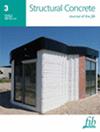Method for prediction of the frost resistance ability of air‐entrained concrete based on the 3D air void characteristics by x‐ray micro‐CT
IF 3.3
3区 工程技术
Q2 CONSTRUCTION & BUILDING TECHNOLOGY
引用次数: 0
Abstract
In modern construction, one of the most important factors in the execution of contracts is time. Standard procedures for assessing the frost resistance or concrete are usually very time‐consuming and can take up to 40 days. The current paper is experimentally and practically oriented. It presents an alternative testing method, based on air void network, that allows to assess the frost resistance of concrete within just a few days of taking the samples. X‐ray micro‐CT scans were introduced to obtain the quantitative and qualitative 3D information about the air void microstructure taking into account total air content:基于 X 射线微计算机断层扫描三维气隙特征的引气混凝土抗冻能力预测方法
在现代建筑中,执行合同的最重要因素之一就是时间。评估混凝土抗冻性的标准程序通常非常耗时,可长达 40 天。本文以实验和实践为导向。它提出了一种基于空气空隙网的替代测试方法,可在取样后几天内评估混凝土的抗冻性。通过 X 射线显微 CT 扫描,可获得有关气隙微观结构的定量和定性三维信息,同时考虑到总空气含量:A(%)、直径小于 300 μm 的孔隙含量:A300(%)、空隙比表面:α(mm-1)和间距系数:L(毫米)来预测冻融耐久性。为了验证抗冻方法的假设,在分析孔隙微观结构的基础上,根据欧洲标准的波兰补充标准进行了抗冻融试验。研究结果表明,适当的气孔微观结构,特别是直径小于 0.3 毫米的微孔含量,可以提高抗冻性:A300 结合间距系数L(毫米)可作为确定混凝土冻融耐久性的可靠依据。因此,本文提出的方法可在短时间内有效地用于快速、可靠地测定含气混凝土的耐久性,且无需对测试样本进行任何特殊处理,以便在需要时立即采取预防或修复措施。
本文章由计算机程序翻译,如有差异,请以英文原文为准。
求助全文
约1分钟内获得全文
求助全文
来源期刊

Structural Concrete
CONSTRUCTION & BUILDING TECHNOLOGY-ENGINEERING, CIVIL
CiteScore
5.60
自引率
15.60%
发文量
284
审稿时长
3 months
期刊介绍:
Structural Concrete, the official journal of the fib, provides conceptual and procedural guidance in the field of concrete construction, and features peer-reviewed papers, keynote research and industry news covering all aspects of the design, construction, performance in service and demolition of concrete structures.
Main topics:
design, construction, performance in service, conservation (assessment, maintenance, strengthening) and demolition of concrete structures
research about the behaviour of concrete structures
development of design methods
fib Model Code
sustainability of concrete structures.
 求助内容:
求助内容: 应助结果提醒方式:
应助结果提醒方式:


